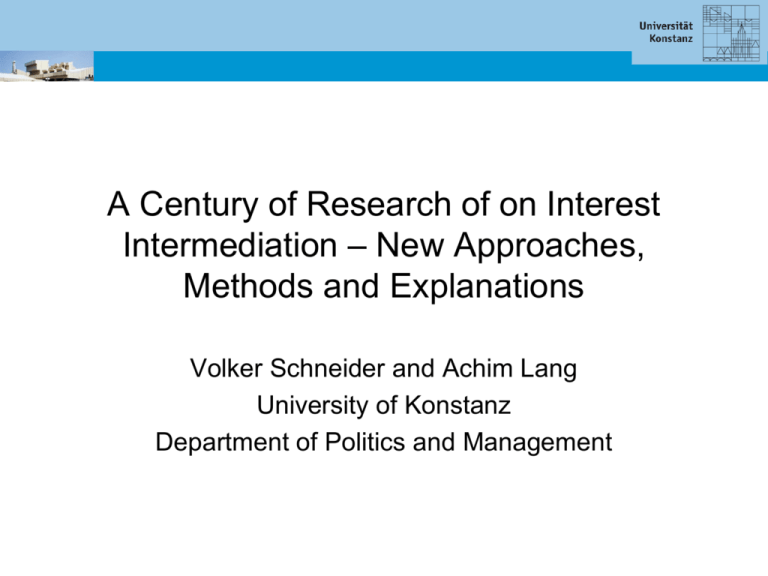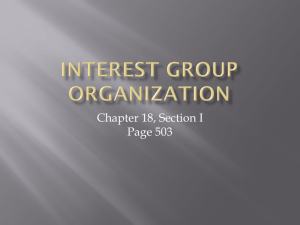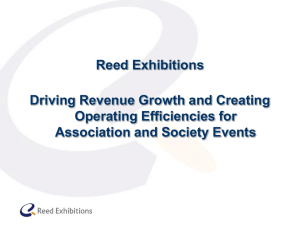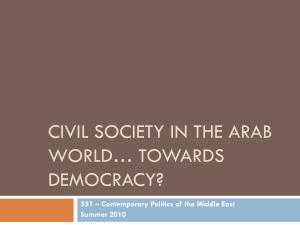Evolution of Business Associations
advertisement

A Century of Research of on Interest Intermediation – New Approaches, Methods and Explanations Volker Schneider and Achim Lang University of Konstanz Department of Politics and Management Three innovations in the book New theoretical perspective • Introduction of basic concepts of complexity theory into the research on business associations • Emphasis on ecological models within the complexity paradigm Application of new methods • Use of social network analysis as a new tool in associational research in order to address relational complexity • Analysis of multiplex relations among business associations Explanation how business associations respond to changes • Conceptualization and analysis of changing positions due to globalization & Europeanization as a complex adaptation process • Test of different theories: • Punctualistic impact theory versus gradualist modernization theory • A synthesis in a complexity perspective The complexity paradigm as a conceptual network The evolution of theories of business associations Marxism and Pluralism Marxism (since 1880s) Explanandum: Interest groups express and represent different class interests in capitalist society, mainly Capital and Labor Assumptions: Positions in economic structures fully determine class interests. • Capitalists have important structural advantages to organize and express their class interests; business associations represent the dominant class interest in capitalist society • Labor has to solve the organizational problem of interest heterogenity Pluralism (1900s) Explanandum: Formation of interest groups and governmental action/policies. Assumptions: High differentiation of modern society and multiplicity of interests • Interest group formation: collective interests explain collective action; business associations are only one group among many others • Policy outcomes: resultant force in a parallelogram of multiple group pressures. Systems theory and Neo-corporatism Systems theory (1960s) Explanandum: Emergence of specialized interest groups and their functions and outputs Assumption: Interest groups fulfill political roles and functions shaped by the overall political system • Level of differentiation specificity of political functions • In modern systems interest groups specialize in interest articulation. Neo-corporatism (1970s) Explanandum: functions of associations and associational subsystems in political systems and policy outcomes Assumption: utility maximizing and rationally acting policymakers and lobbyists. • Structures of associational systems are the result of historical group struggles and/or bargaining outcomes. • Policy outputs within corporatist arrangements are bargaining outcomes among large organized groups, i.e. capital and labor, but also specialized associations at the sectoral level (meso-corporatism). Transaction Cost Theory Explanandum: the establishment of governance modes Assumptions: exchange relations add additional transaction costs to the production costs • Transaction costs may arise before and after transactions have taken place: • Ex ante transaction costs: information, negotiation and contracting costs. • Ex post transaction costs: enforcement and arbitration costs. • Transaction cost theory compares governance alternatives (market, hybrid, and hierarchy): • • costs they pose on economic transactions in different environments. different capacities to adapt to environmental turmoil. • Business associations: hybrid governance (collective self-regulation) • Regulation of intra-industry competition • Regulation of between industry relations (customers and suppliers) Associational governance: lowers industries ex ante transaction costs Collective Action/Public Choice Theory Collective Action Theory (since 1960s) Explanandum: formation and behavior of interest groups. Assumptions: utility maximizing and rationally acting individuals. • Large groups: free-rider behavior Non-exclusion from gains of collective action. “Selective incentives”: positive inducements, restricted to membership. • Small groups: individual gain exceeds the cost of providing collective good. Public Choice Theory (since 1960s) Explanandum: policy outcomes, its distributive effects and social costs. Assumptions: utility maximizing and rationally acting policymakers and lobbyists. • • Policy outcomes = interest groups pressure (money and information). Uncertainty: political, social and economic consequences of legislative activities, affects interest group „success“. Exchange Theory Political Entrepreneurship (since 1960s) Explanandum: formation and management of interest groups. Assumptions: utility maximizing and rationally acting individuals. Formation: the political entrepreneur initiates the formation of interest groups by • Investing his capital. • Past experience: subdivisions of older associations, formerly employed by other assoc. Management: distribution of tasks to members and management of external relationships. Corporate Actor Theory (since 1960s) Explanandum: formation and supervision of interest group, system of political exchange. Formation: individuals (or corporate actors) pool resources and set up a constitution for the interest group. Supervision: set up of organizations within the corporate actor (e.g. supervisory board). System of political exchange: parties, business, legislators and voters. • Each actor strives to control certain outcomes within the political system. • Exchange of (scarce) resources at market price. Organization Ecology Population Ecology (since 1980s) Explanandum: abundance and frequency of associational forms. Assumptions: population as basic unit of analysis. • • • Variation: founding of new associations, deliberately or accidentally internal change. Competition: for scarce resources, some associational forms prove more successful. Selection: environments differentially select associations for survival on the basis of fit between associational form and environmental characteristics. • Retention: over time more successful associational forms have a higher survival rate and become more frequent within a population. Niche Theory (since 1990s) Assumptions: interest groups act in well defined niches. Niche overlap between associations leads to a partitioning of that niche. Two mechanisms: • Associations compete over the share of overlap until this share is partitioned. Associations become dissimilar over time. • Associations actively cooperate (consensus over the partitioning) of the overlap. Associations become similar over time. Comparison Ecological Analysis of Business Associations Evolution of Business Associations: Foundings, mergers and split-ups. Ecological Relations: Cooperation, Competition and Neutrality. Species: Types of business associations Multi-level lobbyists, service providers, etc. Industries Time period • Chemical industry (consolidated). 1987-2002 • Information and communications industry (in the making). Research Question: Do business associations in different industries evolve differently (varieties of capitalism)? Or do they share similar characteristics (globalization, Europeanization)? Chemical Industry Associations UK GER Findings: • Few foundings of business associations. • No mergers in UK and GER, few in the US. • Few split-ups in GER and US. Low population dynamics. Some dynamics in biotech and pharmaceutical industry. USA Chemical Industry Associations UK Competition GER Cooperation USA Neutrality Findings: • Few changes in network structure induced by newly founded associations. • Cooperative relations dominate. • Some competitive relations (induced by biotech and pharmaceutical associations). • Formal (GER) and informal (US) hierarchies still prevail. Information- and Communications Industry Associations UK GER Findings: • Many foundings of business associations. • Some mergers in GER and the US. • Few split-ups in GER and US. High population dynamics. Dynamics in communications industry (telecom, internet). No dynamics in „old“ media industries (print, press). USA Information- and Communications Industry Associations UK Competition GER Cooperation USA Neutrality Findings: • Many changes in network structure induced by newly founded associations. • No relation dominates network structure. • Many competitive relations (induced by telecom/internet associations). • No formal and informal hierarchies existent. Major Findings Evolution of Business Associations: More foundings, mergers and split-ups in the emergent IC industry. Ecological Relations: • More cooperation between chemical industry associations. • More competition between IC industry associations. Species: Types of business associations IC industry associations more heterogeneous. Globalization, Europeanization: No uniform and homogenizing effect. Varieties of Capitalism On a sectoral basis, not nationally determined: technological innovations change market structure new niches foundings of business associations niche overlap increasing competition.







